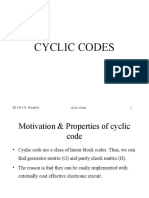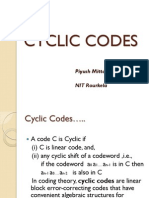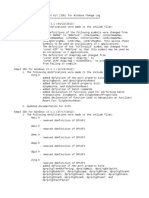Linear Block Codes: Cyclic Codes: R Q NK N R N
Uploaded by
DuongMinhSOnLinear Block Codes: Cyclic Codes: R Q NK N R N
Uploaded by
DuongMinhSOnLinear block codes: Cyclic codes
For practical applications rather large n and k must be used. This is
because in order to correct up to t errors lhs and rhs of the following
should be as close as possible:
Hence for large n and k must be used
Advantages of cyclic codes:
Encoding and syndrome computation easy by shift registers
Handy decoding schemes exist due to inherent algebraic structure
For most of the linear codes there exist cyclic codes, as for instance for
Hamming, BCH and Golay codes
1
2 1 ...
1 2
n k
n
t
i
n
i
n n n
t
=
=
| | | | | | | |
+ + + =
| | | |
\ . \ . \ . \ .
number of syndromes
(or check bit error patterns)
number of error patters
that can be corrected
in an encoded word
2
1
1
1 log note: (1 )
C C
t
i
n
i
R q n k n R
n
=
( | |
= =
| (
\ .
1
C
R
min
( 1) / 2 t d =
Example
Consider a relatively high SNR channel such that only 1 or 2 bit errors
are likely to happen. Consider the ration
Take a constant code rate of R
c
=0.8 and consider with some values of
larger n and k :
This demonstrates that long codes are more advantages when a high
code rate and high error correction capability is required
2
2
1
1
1 log
1 /
( , )
1
log
1 2
C
t
i
n
i
R
n
k n
n k
n n
n
=
( | |
| (
\ .
=
( | | | |
+
( | |
\ . \ .
(10,8) 0.35, (32, 24) 0.89, (50, 40) 0.97 = = =
Defining cyclic codes: code polynomial
An (n,k) linear code X is called a cyclic code when every cyclic shift of
a code X, as for instance X, is also a code, e.g.
Each cyclic code has the associated code vector with the polynomial
Note that the (n,k) code vector has the polynomial of degree of n-1 or
less. Mapping between code vector and code polynomial is one-to-one,
e.g. they specify the same code uniquely
Manipulation of the associated polynomial is done in a Galois field (for
instance GF(2)) having elements {0,1}, where operations are performed
mod-2
For each cyclic code, there exist only one generator polynomial whose
degree equals the number of check bits in the encoded word
2 1
0 1 2 1
( )
n n
n n
p x x p x p x p
= + + + + X
0 1 2 1
( )
n n
x x x x
= X
1 0 3 2
' ( )
n n n
x x x x
= X
An example of a (7,4) cyclic code,
generator polynomial G(p)=1+p+p
3
( ) p M ( ) p X ( ) ( ) p p M G
( )( )
3
1 1
1
X X X
X
+ + +
= +
3
X X + +
2 4
X X + +
The common factor of cyclic codes
GF(2) operations (XOR and AND):
Cyclic codes have a common factor p
n
+1. In order to see this we
consider summing two (unity shifted) cyclic code vectors:
Question is how to make the cyclic code from the multiplied code?
Adding the last two equations together reveals the common factor:
Modulo-2 Addition
+ 0 1
0 0 1
1 1 0
Modulo-2 Multiplication
* 0 1
0 0 0
1 0 1
2 1
1 0 1 2
2 1
0 1 2 1
2 1
0 1 2 1
( )
'( )
( )
n
n n
n n
n n
n n
n n
p x x p x p x p
p x x p x p x p
p p x p x p x p x p
= + + + +
= + + + +
= + + + +
X
X
X
1 1 1
( ) '( ) ( 1)
n n
n n n
p p p x p x x p
+ = + = + X X
Right rotated
Right shifted by multiplication
Unshifted
Factoring cyclic code generator polynomial
Any factor of p
n
+1 with the degree q=n-k generates an (n,k) cyclic code
Example: Consider the polynomial p
7
+1. This can be factored as
For instance the factors 1+p+p
3
or 1+p
2
+p
3,
can be used to generate an
unique cyclic
code. For a message polynomial 1+p
2
the following
encoded word is generated:
and the respective code vector (of degree n-1, in this case) is
7 3 2 3
1 (1 )(1 )(1 ) p p p p p p + = + + + + +
2 3 2 5
(1 )(1 ) 1 p p p p p p + + + = + + +
(111 0 0 1 0)
Obtaining a cyclic code from another cyclic code
Therefore unity cyclic shift is obtained by multiplication by p where
after division by the common factor yields a cyclic code
and by induction, any cyclic shift is obtained by
Example:
right shift 101
Important point is that division by mod p
n
+1 and multiplication by the
generator polynomial is enabled by tapped shift register.
'( ) ( ) mod( 1)
n
p p p p = + X X
( ) ( )
( ) ( ) mod( 1)
i i n
p p p p = + X X
2
101 ( ) 1 p p = + X
3
( ) p p p p = + X
3 3
( )
1 110
1 1
1 p p
p p
p
= +
+
+
+
X
not a three-bit code,
divide by the common factor
3 3
3
1
1
1
1
p p p
p
p
+ +
+
+
Using shift registers for multiplication
Figure shows a shift register to realize multiplication by 1+p
2
+p
3
In practice, multiplication can be realized by two equivalent topologies:
Example: multiplication by using a shift register
2 3
2 3
(1 )(1 )
1
p p p
p p
+ + +
= + +
3
p p + +
4
2 4
1 11101
p
p p p
+
= + + +
out
1 1 0 0 0 0 0 1
0 1 1 0 0 0 0 1
0 0 1 1 0 0 0 1
0 0 0 1 1 0 0 0
0 0 0 0 1 1 0 1
0 0 0 0 0 1 1 0
determined by
the tapped connections
word to be
encoded
Encoded word
Examples of cyclic code generator polynomials
The generator polynomial for a (n,k) cyclic code is defined by
and G(p) is a factor of p
n
+1. Any factor of p
n
+1 that has the degree q
may serve as the generator polynomial. We noticed that a code is
generated by the multiplication
where M(p) is a block of k message bits. Hence this gives a criterion to
select the generating polynomial, e.g. it must be a factor of p
n
+1.
Only few of the possible generating polynomials yield high quality
codes (in terms of their minimum Hamming distance)
1
1 1
( ) 1 ,
q q
q
p g p g p p q n k
= + + + + = G
( ) ( ) ( ) p p p = X M G
Some cyclic codes:
3
( ) 0 1 p p p = + + + G
Systematic cyclic codes
Define the length q=n-k check vector C and the length-k message
vector M by
Thus the systematic n:th degree codeword polynomial is
1
0 1 1
( )
k
k
p m m p m p
= + + + M
1
0 1 1
( )
q
q
p c c p c p
= + + + C
1
0 1 1
1
0 1 1
( ) ( )
( ) ( )
n k k
k
q
q
q
p p m m p m p
c c p c p
p p p
= + + +
+ + + +
= +
X
M C
Check bits determined by:
Question: Why these denote the message bits still
the message bits are M(p) ???
| |
( ) mod ( ) / ( )
n k
p p p p
= C M G
check bits
message bits
Determining check-bits
Prove that the check-bits can be calculated from the message bits
M(p) by
| |
( ) mod ( ) / ( )
n k
p p p p
= C M G
( ) / ( ) ( ) ( ) / ( )
n k
p p p p p p
= + M G Q C G
0
( ) / ( ) ( ) / ( ) ( ) ( ) / ( ) ( ) / ( )
n k
p p p p p p p p p p
=
+ = + + M G C G Q C G C G
( )
( ) ( ) ( ) ( )
n k
p
p p p p p
=
+ =
X
M C G Q
check message
3 2
3
7 4 6 4
( ) 1
( )
( )
p p p
p p p
p p p p
= + +
= +
= +
G
M
M
3 2
3 3 6 4
3 2 3 2 6 4
( )
( )
( ) / ( ) 1 1
( ) ( ) ( ) 1 1
( ) ( ) ( 1)( 1) 1
n k
n k
p
p
p p p p p
p p p p p p p p
p p p p p p p p
= + + +
+ = + + = + +
= + + + + = + +
C
Q
M G
M C
Q G
Example: (7,4) Cyclic code:
must be a systematic code
based on its definition
(previous slide)
10/ 2 / 4 4 2 = +
( ) p C
Example: Encoding of systematic cyclic codes
Circuit for encoding systematic cyclic codes
We noticed earlier that cyclic codes can be generated by using shift
registers whose feedback coefficients are determined directly by the
generating polynomial
For cyclic codes the generator polynomial is of the form
In the circuit, first the message flows to the transmitter, and feedback
switch is set to 1, where after check-bit-switch is turned on, and the
feedback switch to 0, enabling the check bits to be outputted
2 1
1 2 1
( ) 1
q q q
q q
p g p g p g p p
= + + + + + G
1
0
Decoding cyclic codes
Every valid, received code word R(p) must be a multiple of G(p),
otherwise an error has occurred. (Assume that the probability for noise
to convert code words to other code words is very small.)
Therefore dividing the R(p)/G(p) and considering the remainder as a
syndrome can reveal if the error has happened and sometimes also to
reveal in which bit (depending on code strength)
Division is accomplished by a shift registers with reversed
tap order (why?)
The error syndrome of n-k-1 degree is therefore
This can be expressed also in terms of error E(p) and the
code word X(p)
| |
( ) mod ( ) / ( ) p p p = S R G
( ) ( ) ( ) p p p = + R X E
| | { }
| |
( ) mod ( ) ( ) / ( )
( ) mod ( ) / ( )
p p p p
p p p
= +
=
S X E G
S E G
hence
Decoding cyclic codes: example
| |
16.20 ( ) mod ( ) / ( ) s x e x g x =
Using denotation of this example:
( ) g x
| |
( ) mod ( ) / ( ) s x r x g x =
Table 16.6
Decoding cyclic codes (cont.)
Decoding circuit for (7,4) code
syndrome computation
While first receiving the code, switch is set to 0
The shift register is stepped until all the received code bits have entered
the register
This results 3-bit syndrome (n - k = 3 ) that is then left to the register
Then the switch is turned to the direction 1 that drives the syndrome
out of the register
3
( ) 1 p p p = + + G
1
0
received code syndrome
Convolutional coding
Block codes are memoryless
Convolutional codes have memory that utilizes previous bits to encode
or decode following bits
Convolutional codes are specified by n, k and constraint length that is
the maximum number of information symbols upon which the symbol
may depend
Thus they are denoted by (n,k,L), where L is the code memory depth
Convolutional codes are commonly used in applications that require
relatively good performance with low implementation cost
Convolutional codes are encoded by circuits based on shift registers and
decoded by several methods as
Viterbi decoding that is a maximum likelihood method
Sequential decoding (performance depends on decoder
complexity)
Feedback decoding (simplified hardware, lower performance)
Example: convolutional encoder
Convolutional encoder is a finite state machine processing information
bits in a serial manner
Thus the generated code word is a function of input and the state of the
machine at that time instant
In this (n,k,L)=(2,1,2) encoder each message bit influences a span of
n(L+1)=6 successive output bits that is the code constraint length
Thus (n,k,L) convolutional code is produced that is a 2
n(L-1)
state finite-
state machine
2 1
'
j j j j
x m m m
=
2
''
j j j
x m m
=
1 1 2 2 3 3
' '' ' '' ' '' ...
out
X x x x x x x =
(n,k,L) = (2,1,2) encoder
(3,2,1) Convolutional encoder
3 2
'
j j j j
x m m m
=
3 1
''
j j j j
x m m m
=
2
'''
j j j
x m m
=
Here each message bit influences
a span of n(L+1)=3(1+1)=6
successive output bits
Generator sequences
(n,k,L) Convolutional code can be described by the generator sequences
that are the impulse responses for each coder output branch:
Generator sequences specify convolutional code completely by the
generator matrix
Encoded convolutional code is produced by matrix multiplication of the
input and the generator matrix
1 2
, ,...
n
g g g
1
2
[1 011]
[1111]
=
g
g
(2,1, 3) encoder
Note that the generator sequence length
exceeds register depth by 1
Encoding equations
Encoder outputs are formed by modulo-2 discrete convolutions:
Therefore the l:th bit of the j:th output branch is
Input for extraction of generator sequences is
Hence for this circuit the following equations result:
(1) (1)
( 2) ( 2)
*
*
=
=
v u g
v u g
( ) ( ) ( ) ( ) ( )
0
0 1 1
... , 1, 2... , 2
j j j j j m
i
l l i i l l l m m
v u g u g u g u g j m m L
=
= = + + + = = +
,
0, otherwise
l i
i l i
u
(1)
2 3
( 2)
1 2 3
l l l l
l l l l l
v u u u
v u u u u
= + +
= + + +
1
2
[1 0 11]
[111 1]
=
| |
|
=
\ .
g
g
(1) ( 2) (1) ( 2) (1) ( 2)
0 0 1 1 2 2
[ ...] v v v v v v = v
Encoder output:
Example of using generator matrix
1
2
[1 0 11]
[111 1]
=
| |
|
=
\ .
g
g
Verify that you can obtain the result shown!
11 10
01
11 00 01 11 01 =
2 1
'
j j j j
x m m m
=
2
''
j j j
x m m
=
1 1 2 2 3 3
' '' ' '' ' '' ...
out
X x x x x x x =
Tells how one input bit
is transformed into two output bits
(initially register is all zero)
Representing convolutional code: code tree
Representing convolutional codes compactly:
code trellis and state diagram
Shift register states
Input state 1
indicated by dashed line
You might also like
- Hourglass Workout Program by Luisagiuliet 276% (21)Hourglass Workout Program by Luisagiuliet 251 pages
- Read People Like A Book by Patrick King-Edited57% (82)Read People Like A Book by Patrick King-Edited12 pages
- Livingood, Blake - Livingood Daily Your 21-Day Guide To Experience Real Health77% (13)Livingood, Blake - Livingood Daily Your 21-Day Guide To Experience Real Health260 pages
- Donald Trump & Jeffrey Epstein Rape Lawsuit and Affidavits83% (1016)Donald Trump & Jeffrey Epstein Rape Lawsuit and Affidavits13 pages
- The 36 Questions That Lead To Love - The New York Times91% (35)The 36 Questions That Lead To Love - The New York Times3 pages
- The 36 Questions That Lead To Love - The New York Times95% (21)The 36 Questions That Lead To Love - The New York Times3 pages
- Jeffrey Epstein39s Little Black Book Unredacted PDF75% (12)Jeffrey Epstein39s Little Black Book Unredacted PDF95 pages
- 14 Easiest & Hardest Muscles To Build (Ranked With Solutions)100% (8)14 Easiest & Hardest Muscles To Build (Ranked With Solutions)27 pages
- The 4 Hour Workweek, Expanded and Updated by Timothy Ferriss - Excerpt23% (954)The 4 Hour Workweek, Expanded and Updated by Timothy Ferriss - Excerpt38 pages
- Cyclic Codes: Saravanan Vijayakumaran Sarva@ee - Iitb.ac - inNo ratings yetCyclic Codes: Saravanan Vijayakumaran Sarva@ee - Iitb.ac - in25 pages
- Cyclic Codes: Generation of Cyclic Codes: A) Nonsystematic Cyclic Codes: (Multiplicative)No ratings yetCyclic Codes: Generation of Cyclic Codes: A) Nonsystematic Cyclic Codes: (Multiplicative)11 pages
- S.72-227 Digital Communication Systems: Cyclic CodesNo ratings yetS.72-227 Digital Communication Systems: Cyclic Codes29 pages
- Linear Block Codes: Lecture Notes by Y. N. TrivediNo ratings yetLinear Block Codes: Lecture Notes by Y. N. Trivedi12 pages
- Study and Analysis of Data Encryption Te PDFNo ratings yetStudy and Analysis of Data Encryption Te PDF4 pages
- KNL 3503 Information Theory and Error Coding: Prepared by Kho Lee ChinNo ratings yetKNL 3503 Information Theory and Error Coding: Prepared by Kho Lee Chin28 pages
- EC401 M5-Information Theory & Coding-Ktustudents - in PDFNo ratings yetEC401 M5-Information Theory & Coding-Ktustudents - in PDF71 pages
- Cyclic Codes: Wireless Information Transmission System Lab100% (1)Cyclic Codes: Wireless Information Transmission System Lab119 pages
- Digital Communication Systems by Simon Haykin-103No ratings yetDigital Communication Systems by Simon Haykin-1036 pages
- Digital Communication Systems by Simon Haykin-104No ratings yetDigital Communication Systems by Simon Haykin-1046 pages
- Cyclic Codes: Overview: EE 387, John Gill, Stanford University Notes #5, October 22, Handout #15No ratings yetCyclic Codes: Overview: EE 387, John Gill, Stanford University Notes #5, October 22, Handout #1524 pages
- Information and Coding Theory ECE533 - Lec-6 Cyclic Codes v4.0No ratings yetInformation and Coding Theory ECE533 - Lec-6 Cyclic Codes v4.07 pages
- Design and Implementation of FPGA Based Cyclic CodeNo ratings yetDesign and Implementation of FPGA Based Cyclic Code13 pages
- Cyclic Codes: Review: EE 387, October 28, 2015 Notes 15, Page 1No ratings yetCyclic Codes: Review: EE 387, October 28, 2015 Notes 15, Page 118 pages
- Advance Coding Theory V5.1-Lec-5 Cyclic CodesNo ratings yetAdvance Coding Theory V5.1-Lec-5 Cyclic Codes7 pages
- Digital Signal and Image Processing using MATLAB, Volume 3: Advances and Applications, The Stochastic CaseFrom EverandDigital Signal and Image Processing using MATLAB, Volume 3: Advances and Applications, The Stochastic Case3/5 (1)
- 10+2 Level Mathematics For All Exams GMAT, GRE, CAT, SAT, ACT, IIT JEE, WBJEE, ISI, CMI, RMO, INMO, KVPY Etc.From Everand10+2 Level Mathematics For All Exams GMAT, GRE, CAT, SAT, ACT, IIT JEE, WBJEE, ISI, CMI, RMO, INMO, KVPY Etc.No ratings yet
- Mathematical Formulas for Economics and Business: A Simple IntroductionFrom EverandMathematical Formulas for Economics and Business: A Simple Introduction4/5 (4)
- Case Analysis: The Paradoxical Twins: Acme and Omega ElectronicsNo ratings yetCase Analysis: The Paradoxical Twins: Acme and Omega Electronics2 pages
- Seminar Report: "Touch Screen Technology"No ratings yetSeminar Report: "Touch Screen Technology"6 pages
- Appendices For AAAI'10 Submission Number 746: ANo ratings yetAppendices For AAAI'10 Submission Number 746: A4 pages
- Using The Javascript Console For Development and AdministrationNo ratings yetUsing The Javascript Console For Development and Administration26 pages
- Cbse Class Xii Computer Science Project File On Book Shop 2010 ExamNo ratings yetCbse Class Xii Computer Science Project File On Book Shop 2010 Exam31 pages
- Experiment Title-2.1: To Rotate A Given Triangle Clockwise and Anticlockwise About A Given PointNo ratings yetExperiment Title-2.1: To Rotate A Given Triangle Clockwise and Anticlockwise About A Given Point5 pages
- Selecting A Managed Security Services ProviderNo ratings yetSelecting A Managed Security Services Provider12 pages
- Pervasive Healthcare and Wireless Health MonitoringNo ratings yetPervasive Healthcare and Wireless Health Monitoring15 pages
- Shrimp Rover Robot Using Rocker Bogie MechanicsNo ratings yetShrimp Rover Robot Using Rocker Bogie Mechanics93 pages
- Vishal Julka's Dilemma and GE Countrywide - 19IB35267% (3)Vishal Julka's Dilemma and GE Countrywide - 19IB3524 pages
- STUDENT VERSION - 017 Data Structures and Algorithms V1No ratings yetSTUDENT VERSION - 017 Data Structures and Algorithms V1202 pages























































































































